Caravan leisure batteries: everything you need to know
From basic essentials like lighting and heating to modern conveniences like Bluetooth speakers and solar panels, caravans need a reliable source of power
This is precisely what a caravan leisure battery is designed to do – keep your `van’s electric features juiced up so that you can relax, safe in the knowledge that everything is functioning exactly as it should be.
The thing is, that’s not always the case.
From minor hitches to some (thankfully rarer) major faults, caravan leisure batteries can cause issues, so it’s well worth your time getting to know the ins and outs of these essential sources of power. Featuring practical advice from the regular expert contributors to Caravan magazine, this is your complete guide to leisure batteries for caravans.
Page contents
- What are leisure batteries?
- Different types of leisure batteries for caravans
- Caravan leisure battery maintenance
- Leisure battery safety measures
- Things to consider before buying a caravan leisure battery
- FAQs
- About our magazines
Words by Jack Hart
What are leisure batteries
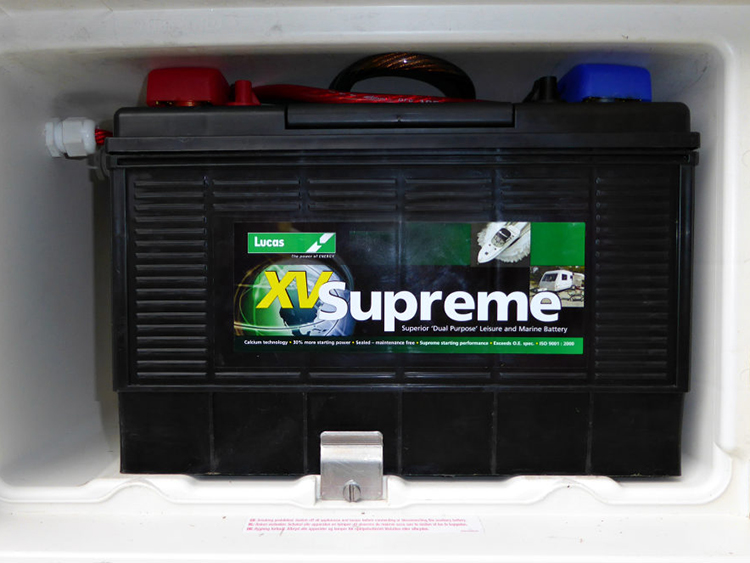
(Photo courtesy of Terry Owen)
In brief, a leisure battery is the power source for anything electrical in your caravan: lighting, heating, the kettle, TV and everything else besides. Unless you’re committed to a particularly Spartan lifestyle, your caravan is likely to include a wide variety of electric conveniences, so a caravan leisure battery is an essential for a comfortable lifestyle.
But what about electric hook-up?
Well, that serves two purposes: both to recharge your leisure battery and to supply power for any appliances using more than 12V.
A caravan leisure battery, like any other type of battery, has only a finite supply of power and needs recharging to keep functioning and to maintain its health. They can keep you going for a short time if you’re planning on heading off-grid in your caravan but the exact duration will depend on what appliances you use and how for long, so it’s best to make sure you don’t stray far from an electric hook-up for too long.
How does a caravan leisure battery work?
Despite common misconception, leisure batteries are not the same as car batteries – they serve entirely different purposes.
Whereas a car battery is used for ignition (and therefore send a big surge of power before being replenished by the alternator), a leisure battery is used to steadily maintain power for low-usage items over a prolonged period of time.
There are various types of leisure batteries for caravans available but they all have this same primary function.
As you can tell from the diagram below, leisure batteries function on a relatively simple circuit to supply power throughout your caravan. This circuit can become more complex when more outputs are added or if solar panels are introduced, which is often where issues creep in!
This example caravan leisure battery wiring diagram outlines exactly how they work:
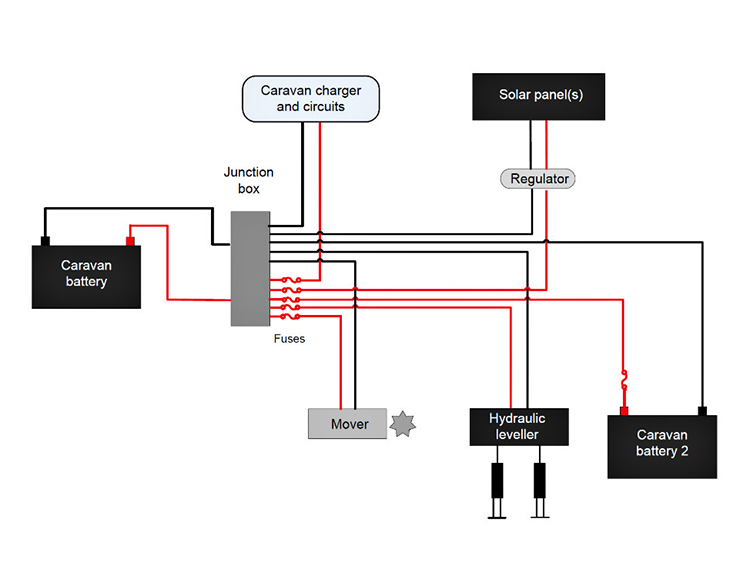
(Photo courtesy of Terry Owen)
Do I need a leisure battery?
The short answer?
Yes, you do need a leisure battery for your caravan.
Some caravans come with an in-built charger but these do not an effectively or reliably as a leisure battery. They have numerous benefits, including allowing you to roam off-grid for short periods of time and providing a smooth regulation of power that keeps both the battery and its connected appliances in tip-top condition.
How long does a caravan leisure battery last?
Typically, a leisure battery will last around five to six years if it’s taken care of and is recharged regularly.
This can vary depending on what type of battery you have and your usage, but it’s a good ballpark figure to work from in terms of battery lifespan. Older batteries, particularly lead-acid ones, need more maintenance to keep functioning effectively and enjoy a convenient lifespan, but many newer batteries need little to no maintenance other than keeping the charge up.
It’s particularly important to keep your leisure battery topped up during winter, when most caravans remain in storage for months and batteries can easily drain their charge. Allowing the battery to drop below a reasonable level can impact its efficiency and its lifespan.
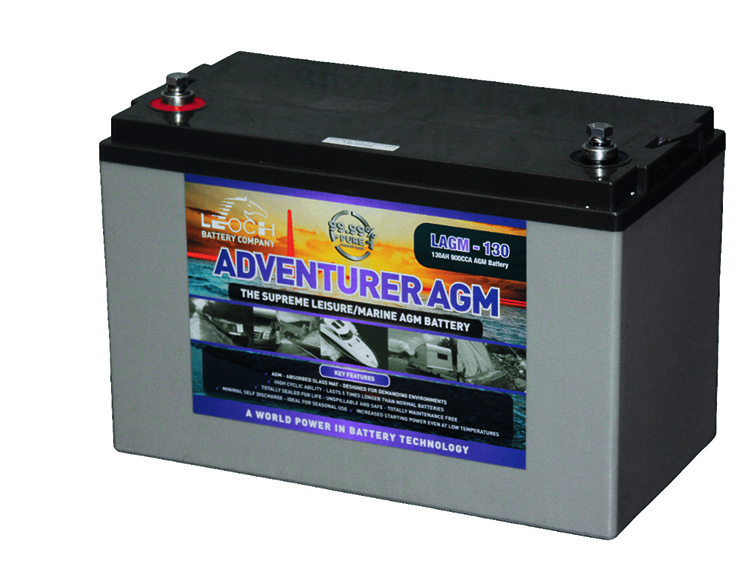
(Photo courtesy of Leoch Battery UK)
How much are caravan leisure batteries?
There’s a wide range of choice when it comes to buying a new leisure battery and you can expect to fork out anywhere between £70 to £900.
The price will depend on the type of battery you choose, which we’ve outlined below.
A decent caravan leisure battery should cost around £140, like this Class B option from Halfords. Of course, you can choose a more advanced, eco-friendly battery from somewhere like Eco Tree, which will cost around £600.
Different types of caravan leisure battery
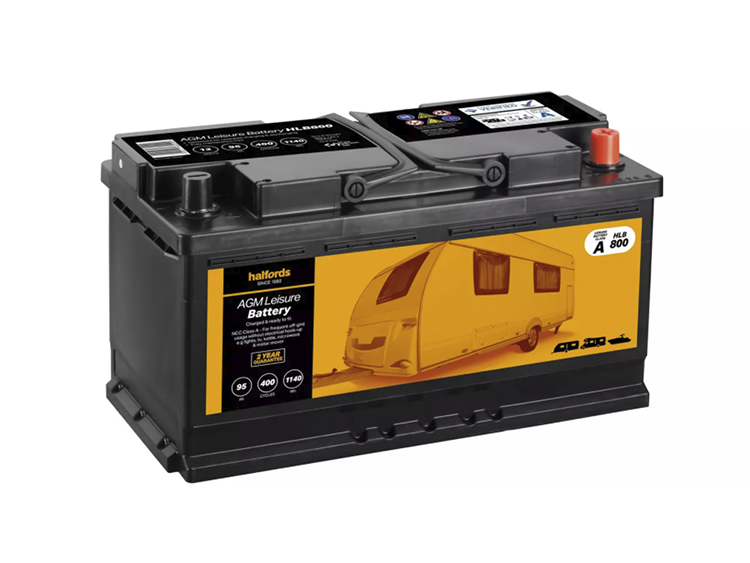
(Photo courtesy of Halfords)
Not all leisure batteries are created equal and there’s a wide degree of variation in the types listed below, including how powerful they are, how easy they are to maintain and, crucially, how expensive they are.
Lead acid leisure batteries
These are among the most common types of leisure battery for caravans but can actually be split into two categories:
- Open: these are the most maintenance-heavy of all the batteries in this list as they need to be topped up with electrolytes to maintain the sulphuric acid solution within, keeping them running effectively. The trade-off for this effort is that they’re also the cheapest!
- Open: these work just as the open batteries do but do not require topping up and remain relatively cheap compared to other types, making them a popular option for caravan owners.
Technically, most of the batteries listed here are lead acid leisure batteries, but the following variations have found innovative ways to make them leak-proof and increase their lifespan.
AGM leisure batteries
There’s only one significant difference between these and regular lead acid batteries:
They feature a glass matt container to house the electrolytes, which eliminates the risk of an acid spillage. It’s an interesting safety feature but does hike the price up, which makes this option a less popular battery type.
Gel leisure batteries
Similarly, to AGM batteries, the difference here is to do with the electrolyte storage, which in this case is contained as a gel, which conveniently reduces the chance of leaks and eliminates any need for maintenance.
Again, though, this has an adverse effect on the price – you just need to weigh up how much you value a low-maintenance battery!
Lead crystal leisure batteries
On that same theme, lead crystal batteries are a great option for eliminating the risk of leaks and spills, since the electrolytes are stored as crystals, as well as increasing the lifespan of the battery, but this does lead to a much more expensive price point.
Lithium leisure batteries
This type of battery gets into the news most commonly with electric bikes and electric cars, usually because something has gone wrong during charging, but they can provide a very powerful and compact power source for your caravan.
The drawback?
If you’ve been paying attention, you’ll know it already – these lithium leisure batteries are significantly more expensive than lead acid batteries.
This is a more advanced technology than standard leisure batteries and should improve in coming years, but for now lithium batteries remain a more controversial choice.
Caravan leisure battery maintenance
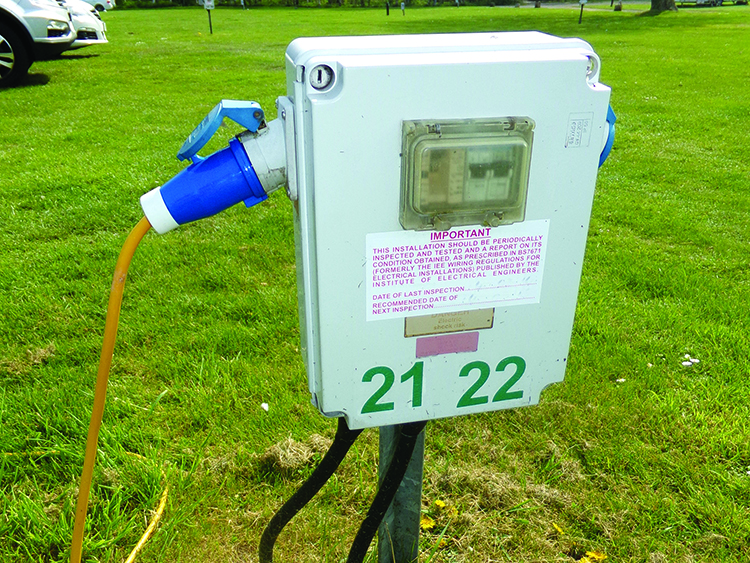
(Staff photo)
As has been mentioned already, some leisure batteries require regular maintenance to remain efficient and to increase their lifespan, while others need no maintenance at all.
How much effort you are willing and able to put into caring for your leisure battery should be a major factor in choosing which type of leisure battery to install into your caravan, second only, perhaps, to cost.
This is particularly true if you are planning to hook it up to multiple outlets - including solar panels - and create a more complex system. Refilling an open lead acid battery with electrolytes will be trickier if it’s wired into a convoluted circuit of your own making!
As a basic checklist, this is what you need to consider to maintain your caravan leisure battery:
Recharge it regularly
Whatever the type of battery you have, letting the charge drop below reasonable levels is going to have a negative impact on its performance and longevity, so recharging at regular intervals is essential.
While many vehicles have in-built chargers, these are usually not sufficient to properly recharge a leisure battery, so removing it from your caravan and using a purpose-built charger is the best course of action.
You can find these at any good motoring store, like these options from GoBatteries.
Of course, the leisure battery will also recharge at an electrical hook-up point on a campsite, but since the battery is being used at the same time, it won’t often reach a full recharge.
Refill electrolytes
This task only applies to open lead acid batteries, which more and more caravan owners are moving away from to reduce the amount of maintenance involved and to spend more time actually using their caravans!
In these open systems, electrolytes need adding to the sulphuric acid solution, known as watering the battery. This is a task that needs due care taken to remain safe, so always wear protective equipment and follow the manufacturer instructions.
How often this needs doing will depend on the frequency with which you use your caravan, so be sure to check the levels frequently, again using manufacturer guidelines.
Clean battery terminals
Again, this task only applies to open lead acid batteries.
On this type of battery, grime can build up on the terminals which can lead to corrosion. Using a solution of baking soda and a toothbrush is the classic fix, which can be a messy and time-consuming job, another reason why caravan owners are flocking to more modern leisure batteries.
Leisure battery safety measures
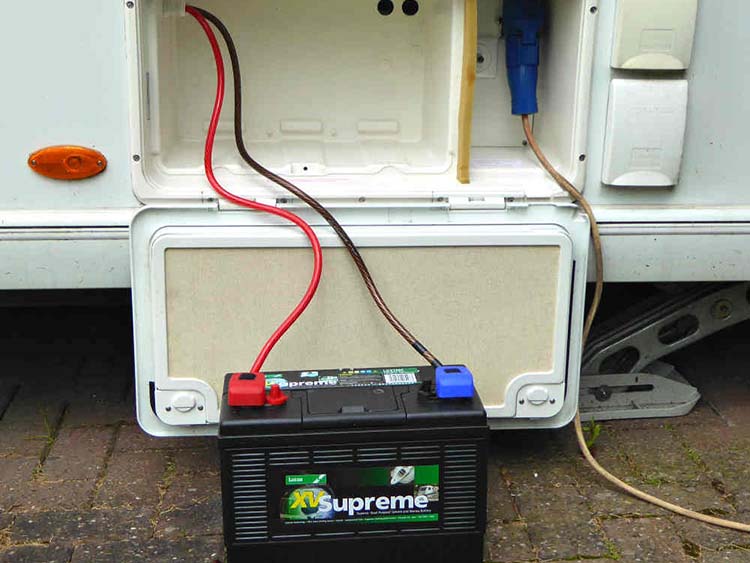
(Photo courtesy of Terry Owen)
Caravan leisure batteries are perfectly safe to use when treated well but it is worth emphasising those essential safety measures that will both keep you from harm and ensure the battery works effectively.
Why is this important?
They might power everyday items like kettles and Bluetooth speakers, but caravan leisure batteries are built using a concoction of corrosive acid and highly-pressured gas, so the risk of skin injuries or fire is very real is batteries become damaged.
Take the following safety precautions to protect yourself and the battery:
- Securely mount your leisure battery where it will not be damaged and with a correctly fitted gas escape vent
- Ensure no naked flames are used anywhere in the vicinity of the leisure battery
- Wear protective clothing and equipment when moving or maintaining your leisure battery
- Refer to the manufacturer guidelines to ensure that you are using your leisure battery with all necessary safety precautions
Things to consider before buying a caravan leisure battery
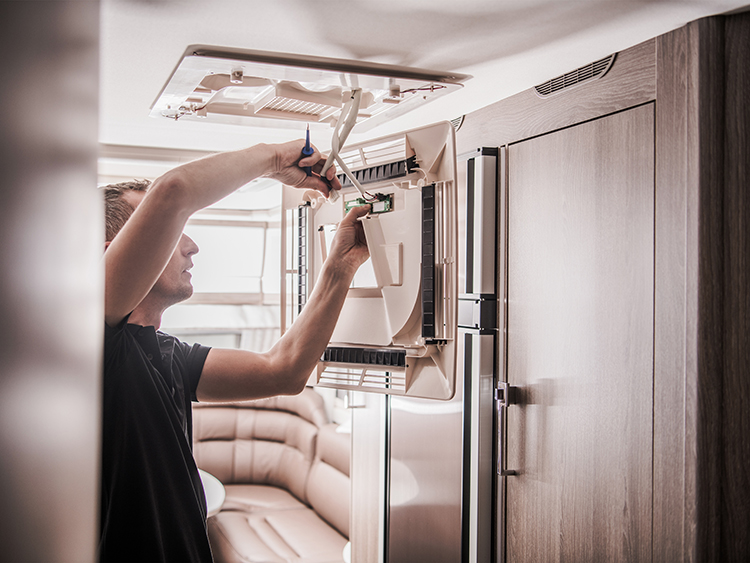
(Photo from Shutterstock)
As has been mentioned in the sections above, your choice of leisure battery will depend on a few key factors:
- How willing and able you are to perform regular maintenance on the battery
- How often you are going to use your caravan off-grid
- How complex your circuit is going to be
- How much you are willing to spend
If you are a committed caravanner and like to get out and about as often as possible, it will likely be worth spending a bit more on your leisure battery to ensure that you have a product which can go toe-to-toe with your demands, recharging efficiently and needing no maintenance between trips.
That's not necessarily true for everyone, though.
People looking to save a bit of cash and who are happy to get their hands dirty might be happier with a cheaper open lead acid leisure battery, which work perfectly well so long as they are cared for appropriately.
It is also worth bearing in mind that if you decide to add more appliances and outputs to your caravan, like a motor mover or roof mounted solar panel, you may end up needing to wire in a second leisure battery to cope with these demands, so purchasing batteries that will work in harmony within the space available will become a consideration.
As you can discern, these considerations are highly individual and need to be looked at on a case-by-case basis.
The key takeaway?
Caravan leisure batteries may look complicated but are actually relatively simple to use and maintain, so long as you’ve chosen a battery that suits your individual needs and understand how to look after it.
With those considerations taken care of, you can hit the open road, safe in the knowledge that your caravan leisure battery is ready to go the distance.
Expert Caravan advice to your door!

Caravan magazine has been inspiring caravanners for more than 80 years! We have grown to become a leading authority on caravans, the caravan industry, caravan lifestyle, campsites and caravan travel destinations. We know what our readers want – and that's to make the most of their caravans and their holidays!
Want to know more about Caravan magazine?
About Caravan magazine







Recent Updates
Caravan cooking recipes
Caravan cookery inspirational ideas. No need to stress out in the kitchen with these quick and easy time-saving dishes ...
Caravan insurance: all you need to know
Navigating the world of caravan insurance can feel like a daunting task. Fear not, as this comprehensive ...
Caravan tyres: everything you need to know
In this tyre guide, we'll explain everything you need to know about looking after your caravan tyres and ...
Caravan solar panels: all you need to know
Whether you dream of roaming off-grid or just fancy reducing your carbon footprint, fitting solar panels to ...
Caravanning with dogs: all you need to know
Caravan holidays with dogs are a joy for lots of reasons. Firstly, many people choose to buy a caravan ...
How to set up a caravan: all you need to know
Setting up your caravan on a campsite pitch is just a sequence of actions. They’re second nature to ...
Caravan showers: all you need to know
In this guide, we’ll discuss the different types of showers, how they work, and how to fit an external shower ...
Caravan towing: all you need to know
Towing a caravan may seem daunting initially, but a few simple tips can make the journey enjoyable and ...
All you need to know about towbars & towballs
Flange, detachable, swan neck, retractable – towbar technology choice is bewildering. Don’t worry. We’ll ...
Caravan WiFi: everything you need to know
Caravan holidays are the ultimate way of getting away from it all, although we sometimes need a link to the ...
Other Articles
Buying a caravan: what you need to know
Let us guide you through some of the complicated things to think about when first looking at buying a caravan, including whether your car will be ...
Caravan awnings: a buyers' guide
Caravan awnings are a fantastic addition to any caravan as they are one of the simplest, quickest and most ...
Caravan electrics: avoid tripping out
All caravan owners have overloaded their mains supply at some time. Here’s how to master caravan electrics ...
Caravan heating systems: a quick guide to caravanning warmth
When winter is here, you’ll be glad of a decent caravan heating system if you’re out touring. Here’s how the ...
Caravan damp: a complete guide
There's little more guaranteed to strike fear into the heart of a caravan owner than the word 'damp'. But if ...
Caravan jockey wheels: the definitive guide
A well-functioning caravan jockey wheel can make all the difference to manoeuvring away from the towcar, ...
Caravan bike racks: a complete guide
Exploring the beautiful surroundings while on a caravan trip is undeniably one of the greatest joys of the ...
The ultimate guide to caravan layouts
Choosing the right layout or floorplan of your caravan is an all-important part of the buying process – find ...
A guide to seasonal caravan pitches
Our in-depth guide to finding and securing seasonal caravan pitches on your favourite campsite ...
Caravan weights and payloads: a quick guide
The terminology of caravan weight – MIRO, MTPLM, noseweight, kerbweight, payload, weight plate upgrade – is ...